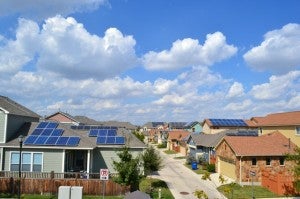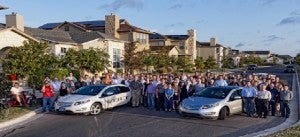
Source: Pecan Street Inc.
With 1.8 gigawatts (GW) of solar power installed in 2011 and an expected 2.8 GW in 2012, it is safe to say that solar energy has solidified its role as an important part of our nation’s energy portfolio. Affordability, competitive financing and reduced greenhouse gases are just a few of the reasons why the number of solar installations has skyrocketed in the past several years.
Now, new research from Dr. Alexis Kwasinski, Dr. Fabian Uriarte, and Amir Toliyat, engineers from the University of Texas at Austin, sheds some light on how rapidly growing solar installations can work with the current electric grid. For their groundbreaking findings in “Effects of high penetration levels of residential photovoltaic generation,” they were recently awarded an Outstanding Paper Award at the International Conference on Renewable Energy Research and Applications (ICRERA) in November for their in-depth research and innovative solutions.
Jump started by a $10.4 million grant from the Department of Energy, Pecan Street Inc. is a “community-wide collaboration to fully reinvent the energy delivery system” based in Austin, Texas. This living ‘smart grid laboratory’ provided a perfect data collection site for the researchers. Pecan Street’s leadership focuses on developing new technologies that reinvent the way we create and use energy, so that residents drive electric vehicles, invest in cutting-edge technology and, of course, use solar panels.
The massive amount of data gathered from Pecan Street’s efforts provided researchers the opportunity to analyze solar energy’s effect on the three key characteristics of “power quality” (voltage level, voltage unbalance and power factor). The researchers found that energy inflections (voltage levels and voltage unbalance) did not create any major concerns with the power grid, despite unfounded claims to the contrary by some solar critics.
Digging further into the data, the researchers unexpectedly found that power factor could become a real issue if solar installers don’t use modern equipment that provides for power factor support. While the issue could become very real at higher levels of solar penetration, the solution is simple, cheap and currently available; it simply means installers should begin using newer models of solar panel “inverters,” which convert solar power into electricity that can be fed into your grid and home.
Inverters simply convert raw DC power to AC power (i.e. the type of electricity we need to use everyday household items). Maximizing the amount of electricity that is converted into usable power makes solar energy more competitive, ensuring that it will remain an important and growing part of our nation’s energy mix.
It’s exciting to see that these researchers are receiving accolades for their groundbreaking work, and international acclaim is always an excellent motivator for this kind of work, but it’s nice to be appreciated where you hang your hat too. Fortunately that doesn’t seem to be a problem, since earlier this year Austinites voted in the Best of Austin 2012 award by the Austin Chronicle for Best Way to Turn Some Green Even Greener. Their choice: Pecan Street Inc.















